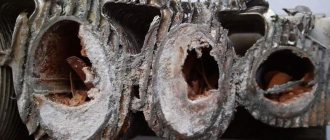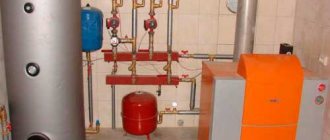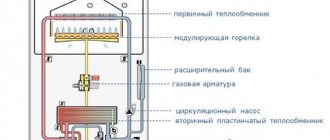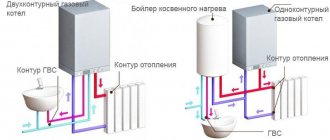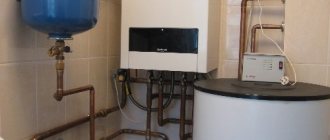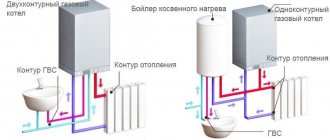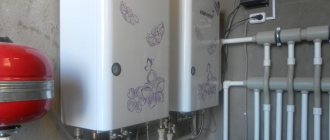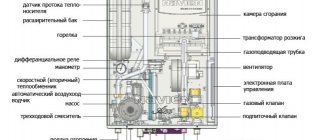If it is not possible to connect to the central gas pipeline, then some owners of private houses decide to install autonomous gasification. The heart of such a system becomes a gas boiler running on liquefied gas - the unit is connected to a gas holder or propane cylinders.
The boiler installation is capable of heating a room of any size. In order for the boiler to provide residents with the appropriate level of comfort, it is necessary to carefully consider the issue of its choice.
We will tell you how a gas unit works, what types of boilers are on the market, and what are the features of their installation and operation. So that you can decide on a purchase, we have listed the main selection criteria and prepared an overview of popular manufacturers of heating equipment.
What are liquefied gas boilers?
It is immediately necessary to clarify that there are no special boilers designed to operate exclusively on liquefied fuel: for this purpose, standard gas units can be used, the factory design of which allows for the possibility of conversion from natural gas to LPG and vice versa.
In addition, a boiler suitable for liquefied gas must have a low operating pressure (3-5 mbar) to ensure more complete fuel production.
What are they for and how are they used?
Organization of operation of propane gas boilers using no more than 1-3 cylinders.
Actually, of the many reasons why homeowners prefer to heat their homes with liquefied fuel, there are several main ones:
- temporary lack of supply or connection of a direct gas pipeline;
- inaccessibility or high cost of other resources in local conditions;
- the need to heat small households (40–100 m2).
The procedure for gasifying a site is often delayed (you need to save money, get permission, approve the project, etc.), so LPG comes to the rescue during such a period.
If we do not consider the option that a person lives in a coal-mining region, then cylinders are cheaper than other fuels, especially electricity.
And a liquefied gas boiler is best suited for small houses, because installing 1–3 cylinders does not take up space and does not require approval.
Design and principle of operation
The operating principle of a classic floor-mounted gas atmosphere.
An LPG boiler functions like any similar device - it burns fuel and directs energy to heat the circulating coolant (water).
But liquefied gas cannot be supplied directly. A standard injection burner has too large nozzles (holes); therefore, it is simply not designed for such fuel: gas enters in excess quantities, which leads to overheating (later to deformation) of the equipment or even to an explosion.
Therefore, initially you need to install nozzles (sprays) of a smaller diameter and connect a reducer (a device for equalizing pressure) - the pressure drop at the outlet of the cylinder will ensure the transition of fuel from liquid to gaseous form. And already in this state it enters the combustion chamber.
This is what the kit for converting the boiler to liquefied gas looks like. It can be ordered together with the boiler or purchased separately. In some models, a replacement kit is already included in the basic configuration.
The heating boiler operating on liquefied gas has no other design features: otherwise it is identical to the traditional unit.
Specifics of operation
To ensure uninterrupted heating of the home, you will have to organize a storage facility, the capacity of which must correspond to the amount of gas reserves:
- group of cylinders on a ramp - a combination of 4–15 cylinders with a volume of 0.2–0.7 m3;
- mobile gas holder – a movable tank with a capacity of 0.4–1.4 m3;
- stationary gas holder - a built-in tank with a capacity of 3–50 m3.
A group of cylinders on a ramp, together with the collectors, is placed in a strong steel box, which is placed at a distance of 1–2 m from the house or mounted to the wall of the building (if the fire resistance is above class III). Short-term supplies (1-3 cylinders) are allowed to be stored directly at home, but not in underground levels.
It is prohibited to store LPG in basements! In the event of a leak, heavy gas settles at the lower building levels, which creates a fire and explosion hazard.
An example of storing a group of cylinders in a steel box against the wall of a private house.
A mobile gas holder (minigas holder) is attached to a trailer (similar to a car) and placed no closer than 10–12 m from a residential building. To avoid condensate freezing during cold periods, the sealed container is equipped with an electric heater that is part of the general heating network.
A stationary gas tank is always installed underground - the tank is completely buried (only the lid and controls remain on top), and gas pipes are extended to the house or boiler room. Due to the walls being surrounded by soil, it does not require additional heating.
Layout of a stationary gas tank on the territory of a private house.
The minimum distance from a stationary gas tank to a residential building is determined by technical supervision authorities depending on the volume of the tank:
- distance ≥ 10 m – volume from 3 to 10 m3;
- distance ≥ 15 m – volume from 10 to 20 m3;
- distance ≥ 20 m – volume from 20 to 50 m3.
Undoubtedly, a stationary gas storage facility is the best option for ensuring continuous operation of the heating system: 1-2 refills are enough for the entire season.
In general, any of these methods of organizing a liquefied fuel storage location is considered acceptable, but subject to safety rules:
- the gas container should not be exposed to direct sunlight;
- its constant external temperature should not exceed + 43…+ 45 °C;
- Gas pipeline pipes must be laid below the soil freezing level.
For the gas boiler itself, you will also need to allocate a suitable place: 10–60 kW units can be installed in residential areas next to gas stoves and radiators, i.e. in a regular kitchen (10–15 m2), and 70–350 kW units are suitable for a room with exit to the street; it is recommended to have a separate boiler room (15–25 m2).
Poll: which option for organizing gas storage is closest to you?
Types of products by location
Equipment operating on liquefied fuel can be floor-mounted or mounted. Each option has specific characteristics that make it attractive and practical under certain conditions.
Having this information in hand, owners can independently determine which device is most suitable for them, and then purchase it in a specialized store.
Option #1: floor equipment
Floor-standing devices are the most widespread. These are high-power units that can provide comfortable heat and hot water not only to standard residential buildings, but also to large-sized country cottages.
The main operating element of the devices is a pressurized gas burner. It has a good degree of efficiency and has high heat dissipation.
Floor-standing devices exhibit stable operation even with a strong drop in gas pressure in the system and reliably serve in intensive use for 15 to 25 years, depending on the manufacturer
The boilers are equipped with a cast iron or steel heat exchanger. The cast iron element is heavy and has a long service life. A steel object is much lighter, but exhibits fragility, sensitivity to mechanical damage and shock, and lasts for a shorter period of time.
In addition to basic elements, progressive modules contain all kinds of auxiliary equipment that increase operational safety. These are sensors for monitoring the draft level, coolant volume and presence of flame, as well as thermostats that block operation in the event of an abnormally high level of heating of the working fluid
Depending on the manufacturer, the device is equipped with a piezo or electronic ignition system. In the first option, the device is started manually by pressing a button.
In the second case, activation occurs automatically, and the boiler does not consume excess fuel during operation, since the system does not have a pilot light with a flame burning continuously.
Detailed information on the selection and installation of floor-standing gas boilers is presented in the articles:
- Floor-standing gas heating boilers: types, how to choose, review of the best brands
- Do-it-yourself installation of a floor-standing gas boiler according to technical installation standards
Option #2: wall mounted devices
Boilers designed for wall mounting are compact in size and have a modern appearance. They take up a minimum amount of space and are suitable for placement in small rooms with complex layouts.
The installation of a mounted boiler is always carried out by a specialist who has experience in such work. The equipment must be installed in accordance with the safety requirements for domestic gas systems
Functionally, wall-hung gas units are no different from floor-mounted ones, however, they have slightly less power and are not very suitable for use in large, spacious houses. But they use fuel economically, while providing a high level of comfort in the living space.
Liquefied gas consumption
The amount of fuel spent on heating depends on the operating conditions of the device and its technical characteristics, usually power and efficiency. So, for example, according to the passport data, for the boiler JSC Zhukovsky AOGV-17.4-3 with a power of 17 kW with an efficiency of 90%, the consumption of liquefied gas is 0.7 kg/h or 1.3 l/h.
Knowing that the cost of refueling in 2022 is 12-23 rubles/l, taking the average value, you can roughly calculate the cost of heating a house over a certain period of time:
- per day (24 hours) – 1.3 × 24 = 31 l × 17 ≈ 527–558 rubles;
- per month (30 days) – 31 × 30 = 930 l × 17 ≈ 15810–16740 rubles;
- for a season (six months) – 930 × 6 = 5580 l × 17 ≈ 94860–100440 rubles.
It must be taken into account that a 50 liter cylinder actually contains 40–42 liters of propane-butane mixture: about 15–20% of the free volume is used to increase the area of gas evaporation, and overfilling leads to a decrease in its production. This means that with a flow rate of 1.3 l/h, one cylinder is enough for approximately 1.5 days.
But not everything is so bad: the numbers in the passport are given on the basis that the unit will always operate at maximum power 24/7, but in reality this only happens in severe frost. In warm weather, the boiler is active only 10–14 hours daily, i.e. the result obtained can be safely reduced by 30–50%.
How to choose a room thermostat and save up to 30% per month on heating
Possibility of connection to other boilers
Even if the equipment will operate from a cylinder for a short time, when choosing a heating device, you need to pay attention to the optimal pressure: it should be 3-4 mbar. This will allow you to make maximum use of the gas from the tank. It is necessary to connect boilers with an efficiency of at least 90-95% to such an energy carrier.
Safety and Setup
In the cylinder, the gas is in a liquefied state, because is pumped there under high pressure. In the gearbox it is reduced, and the fuel is supplied to the heating devices.
To ensure safe and trouble-free operation of such a boiler, the following rules must be observed:
- there can be only one cylinder in the house; if the system consists of several, then a separate room is provided for them;
- the distance from the boiler or convector, as well as other heating equipment to gas containers should be more than 1 m; if there is a protective screen or wall, it can be reduced to 0.5 m;
- on the street, cylinders are hidden in a cabinet made of non-flammable materials, and a corresponding sign is installed on the premises;
- it is recommended to insulate the storage location or make it heated; there should be no pits nearby so that volatile substances do not accumulate there;
- Gas is supplied to each element of the system only from outside the house.
If all fire safety standards and regulations are observed, such a heating scheme does not need to be registered.
If previously gas containers were exclusively metal, now there are composite or metal-composite models; 50 and 80 liter cylinders are most often used. Since shut-off valves are one of the weakest points, it is recommended to install an additional valve on the gas pipeline.
What is needed
Before connecting the gas boiler to the cylinder, you need to purchase the following items:
- gearbox;
- shut-off valves;
- containers with liquefied fuel;
- a heating device with a special burner;
- ramp (it is needed if several cylinders are installed at the same time);
- metal pipes and hoses.
Connection diagram of the cylinder to the boiler
There is a gearbox between the heater and the tank. To ensure long-term operation of the equipment at one gas station, the containers are installed on a special ramp, where they are divided into main and reserve groups. After the fuel runs out in the main cylinders, the system automatically switches to spare ones. When the tanks are filled, the equipment returns to standard operation.
It is cheaper to use one reducer for all cylinders. A more reliable, but costly solution is to install a separate one for each container.
The gas pipeline connecting the fuel tank and the boiler is made of metal pipes with a difference between the outer and inner diameters of more than 2 mm. If they need to be pulled through walls, special passage elements are used. To connect the boiler, a flexible line is used, and the gearbox is connected using a durite (rubber-fabric) hose.
Installing a liquefied gas boiler would be the best option for heating a private home, as it allows you to efficiently heat the building if it is not possible to connect to the mains. To switch to gas supply, it is enough to replace the burner and reconfigure the equipment. An experienced technician will do everything quickly, and the boiler will run on new fuel.
Reviews of domestic boilers: advantages and disadvantages
Having studied the reviews of owners of LPG boilers, you can understand that such devices are quite ambiguous - they have both strengths and obvious weaknesses.
Advantages and disadvantages of operating on reduced gas :
| pros | Minuses |
| autonomy - such devices do not depend on either the increase in utility tariffs or the stability of the gas main | refueling price - if you do not bring gas yourself, the price includes the amount spent on its transportation |
| versatility - reverse adjustment (for natural gas combustion) is possible at any time with minimal cost | regular maintenance – small jets become clogged with sulfurous substances, so they need to be cleaned frequently |
| maintaining cleanliness - bottled fuel, unlike solid fuel, does not form ash, dust, burning, smoke, etc. when burned. | high fire hazard - storing fuel reserves on site requires strict adherence to safety measures |
| environmental friendliness - the majority (91–95%) of LPG waste is carbon dioxide, which is then absorbed by plants | weather dependent - in winter there is a problem of snowdrifts that impede refueling and gearbox icing |
| simplicity of the system - the absence of complex parts ensures protection against accidents and breakdowns, as well as ease of maintenance | additional costs - the final price depends on the excavation estimate, the length of the gas pipeline, the volume of the vessel, etc. |
Users of a heating system powered by LPG are required to constantly check the remaining fuel in the connected tank. This creates certain inconveniences because it is necessary to frequently renew the contents of gas cylinders or immediately pump a sufficient amount of gas into storage.
Despite its simplicity, the refueling process requires care: the slightest carelessness when connecting the gas pipeline line can lead to a leak.
Gas cylinders
Connecting cylinders
A special reducer is used to regulate the pressure Source stroyinstal.ru
Connecting liquefied propane-butane is carried out in exactly the same way as connecting natural methane, but given the fact that the LPG pressure is higher, there should be a reducer at the outlet of the manifold from the cylinders. Only it’s not the same as what you’re used to seeing when connecting a gas stove at the dacha, although the essence is the same - it’s adjusting the pressure. In our situation, it is a device with a regulator and a pressure gauge.
How to choose a gas boiler using liquefied gas?
It is impossible to say in absentia which liquefied gas boiler is better to choose, because its characteristics must strictly correspond to the characteristics of a particular room. Therefore, before purchasing, it is recommended to consult with specialists or independently understand the technical parameters.
Convection or condensation
The operating principle of conventional convection (efficiency 88-92%) and condensing (efficiency 104-109%) gas boilers.
The operating efficiency of an LPG consuming unit largely depends on the method of using the thermal energy released during fuel combustion:
- convection - heats the coolant using the energy obtained from direct combustion of gas, while part of the heat is lost, leaving along with the exhaust gases;
- condensing – “extracts” additional heat by cooling the smoke and condensing steam in a low-temperature heat exchanger (economizer).
Obviously, a condensing boiler is more profitable - it allows you to save 15–20% of fuel, but at the same time the device itself costs 1.5–2 times more than a conventional one.
Differences and criteria for competent selection of condensing gas boilers
Wall or floor
The fundamental difference between suspended and floor-mounted equipment lies not only in the method of its placement, but also in the structural design:
- wall-mounted models - must “fit” into a compact lightweight body; they are distinguished by a steel/copper heat exchanger, usually with more functional automation;
- floor-standing models are not limited in weight and size, therefore they can also have a cast iron heat exchanger, as well as a wider power range (10–60 kW).
Wall-mounted units are equipped with automation, a circulation pump and other energy-dependent elements - practically, the consumer is provided with a mini-heat station ready for operation. Floor-standing boilers are less independent, but many of them are completely independent of electricity.
Single-circuit or double-circuit
A visual principle of operation of double-circuit boilers with priority for hot water supply (DHW).
The number of circuits determines what tasks the gas equipment is designed to perform and what exactly the generated heat will be distributed to:
- single-circuit – intended directly for heating premises;
- double-circuit – responsible for both heating and hot water supply (DHW).
Considering the high consumption of LPG, in order to avoid unnecessary expenses, it is wise to take a single-circuit boiler and connect an indirect heating boiler to it for DHW. However, dual-circuit models also continue to be in demand.
Efficiency
Efficiency factor (efficiency) is an indicator that determines the operating efficiency of the device and the economical use of energy resources.
For boilers that mainly consume reduced fuel, the efficiency value is critical: although there are samples from 85% to 97% on sale, it makes no sense to purchase units with an efficiency below 88% - otherwise, due to the relatively high fuel consumption, the cost of gas home heating will “catch up” with electricity.
Minimum required power
To approximately calculate the boiler power, you can use a simplified formula, where for every 10 m2 of area there is 1 * kW of energy.
*approximate value taking into account a moderate climate and ceilings of 2.5–3 m.
So, for example, to heat an average house of 120 m2, located in Moscow or Moscow Region, the minimum required power of the unit will be 120 ÷ 10 × 1 = 12 kW.
We also recommend making allowances for possible severe frosts and buying a boiler with a reserve of 15–20%, i.e. for a house of 120 m2 ≈ 14 kW. Otherwise, in the cold winter, a comfortable temperature will not always be maintained, or operating at the limit will lead to premature wear of parts.
How to accurately calculate the required boiler power Individual calculation, formula and correction factors
Additional criteria
It is also worth paying attention to additional characteristics: together they will help make the gas boiler more productive and safe:
- protective kit - consists of a safety valve, draft controller, active flame sensor, air vent and backup power supply;
- functional automation - includes modules for auto-ignition, flame adjustment, self-diagnosis, mode programming and external control;
- heat and sound insulation - specially selected casing prevents heat loss (increases the efficiency of the device) and reduces the noise from the burner.
High-quality insulation helps to get rid of pops that accompany auto-ignition, crackling noises and vibrations, which is important when the boiler is indoors.
How does a cylinder boiler work?
Massive construction of country houses leads to difficulties with gas mains. But this is not the only reason why propane boilers are in demand:
- The difference in the price of propane and centralized gas is not so significant.
- When gas is burned, only carbon dioxide is released.
- The security system monitors the operation of the device, preventing breakdowns.
The operating principle of both systems is practically no different.
Liquid gas equipment has the appearance of a rectangular steel body, which looks stylish and modern. Inside there are the following elements:
- burner;
- radiator;
- adjustment system;
- safety system.
Propane boiler diagram:
The burner also ignites automatically or uses electric ignition. The only difference is the diameter of the nozzles. In this case, the holes are narrower to compensate for the greater pressure in the cylinder.
For your home, you can use a double-circuit and single-circuit unit. A device with two circuits is designed for heating and hot water supply (DHW). One circuit can only be used for heating.
Depending on the type of installation, there are wall and floor models. Each of them must be connected to a stationary or coaxial chimney. Equipment with a closed chamber takes air from the street. An open chamber requires good ventilation in the room to maintain the flame in the burner.
The best manufacturers and models: characteristics and prices
The country of manufacture determines the functionality and quality of the unit: given that it is purchased for many years to come, you should not waste your money on dubious equipment offered by the Chinese market. It is better to opt for proven options from European or Russian manufacturers.
Protherm Gepard 23 MOV
Well-known two-circuit mounted model with a power of 23 kW. It has an open combustion chamber (natural draft) and a copper plate heat exchanger: more thermally conductive and resistant to corrosion. Excellent, considering the price category, the automation allows you to fine-tune the operation of the boiler and efficiently consume fuel (max 1.9 l/h).
Manufacturer : Protherm (Proterm), Slovakia.
Bosch Gaz WBN6000-24C RN S5700
The German BOSCH with a power of 24 kW is made of higher quality materials and is not demanding on the quality of fuel and coolant. It is fully adapted to Russian conditions: it is resistant to changes in voltage, pressure and sudden cold snaps (down to – 35 °C). Economical gas consumption (max 1.5 l/h) is ensured by a modulated fan, a three-speed pump, and thermal insulation of the housing.
Manufacturer : Bosch Thermotechnik (Bosch Thermotechnik), Germany-Russia.
Buderus Logamax U072-18K
We can say that this inexpensive single-circuit boiler unit is one of the best liquefied gas boilers for heating a private home: with a power of 18 kW, it consumes fuel very moderately (max 1.5 l/h). And the built-in membrane expansion tank and three-way valve make it easy to convert it to domestic hot water. At the same time, the model is known for its high reliability, character
Manufacturer : Buderus (Buderus), Germany-Russia.
BAXI SLIM 1.150 I
The famous Italian floor-standing boiler of low power (15 kW) is known for its minimal gas consumption (max 1.1 l/h). It is already equipped from the factory with weather-compensating automation, a cast iron heat exchanger and a control module, with an integrated self-diagnosis option. And another important plus is its modest dimensions: for example, its width is only 35 cm.
Manufacturer : Baxi (Baxi), Italy.
Wester Lemax Clever-30
A domestic single-circuit wall-mounted device with a power of 30 kW, which does not depend on the availability of electricity. It can work in a system with both forced and natural coolant circulation, and continuous smooth flame modulation from 30% to 100% can significantly reduce fuel consumption (max 1.7 l/h). With such high efficiency, it is also distinguished by reliability close to European manufacturers.
The only significant drawback is the steel heat exchanger, which has a limited resource (10-14 years).
Manufacturer : Lemax (Lemax), Russia.
Safety Recommendations
Converting the boiler and reconfiguring it to consume liquefied gas dictates the need to “reconfigure” your attitude towards the device for supplying and storing blue fuel.
You must remember that:
- Cylinders or gas tanks, which are gas storage tanks that supply fuel to household appliances as needed, need to be refilled periodically.
- To fill a group of cylinders or a gas holder with gas, you need to contact certified organizations that have equipment to record the weight of the gas in the cylinder and its actual volume in the gas holder.
- Filling closed gas tanks is carried out to 85% of the useful volume of the vessel. This reserve is necessary in case of thermal expansion of the fuel to avoid an explosion.
A non-hazardous situation that requires special attention when replenishing liquefied blue fuel reserves is the filling of liquid with a density different from the density of the previous liquid. Because of this difference, the remaining liquefied gas may not mix with the newly filled portion.
In the tank, due to the difference in density, a kind of two non-connecting sectors are formed, in each of which liquefied gas circulates. However, convective heat exchange will occur at the sector boundary after a short period. After the temperatures are equalized, the densities will be equal and the liquids will be able to mix.
Liquefied gas, like main gas, is a highly flammable, combustible liquid with a high flame propagation speed. To avoid catastrophic situations, you should strictly follow the operating rules and fill the cylinders no more than 85%
Usually this process, meaning direct mixing, is accompanied by intense evaporation of liquefied gas. To avoid associated losses, mixing devices should be used during the filling process. But it is better to choose a method that eliminates the above-described phenomenon.
Replenishing cylinders and gas tanks with blue fuel in general is a process that requires increased attention, otherwise problems can be very serious and even catastrophic. The rapid spread and evaporation of the liquefied gas mixture is recognized as a significant problem.
If the rules for the safe operation of gas-consuming equipment are not violated, main methane rarely explodes. This only happens with significant leaks, if the technical state of the gas in the surrounding space changes dramatically. For example, in a kitchen with obvious signs of a leak, instead of mandatory ventilation, they turn on the light.
When liquefied gas expands in a closed container due to external heating, it will necessarily explode if there is not enough space left in the container for its expansion. Blue fuel burns extremely intensely. Since the gas is quickly absorbed by the atmosphere, the combustion zone expands at high speed.
Prices: summary table
Comparative rating of boilers consuming liquefied fuel :
| Boiler model name | Efficiency, % | power, kWt | LPG consumption, l/h | price, rub. |
| Protherm Gepard 23 MOV | 90 | 23 | ≤ 1,9 | 51 000 |
| Bosch Gaz WBN6000-24C RN | 92 | 24 | ≤ 1,5 | 38 500 |
| Buderus Logamax U072-18K | 92 | 18 | ≤ 1,5 | 39 500 |
| BAXI SLIM 1.150 I | 90 | 15 | ≤ 1,1 | 78 000 |
| Wester Lemax Clever-30 | 90 | 30 | ≤ 1,7 | 51 000 |
Calculation method for natural gas
The approximate gas consumption for heating is calculated based on half the power of the installed boiler. The thing is that when determining the power of a gas boiler, the lowest temperature is set. This is understandable - even when it is very cold outside, the house should be warm.
You can calculate gas consumption for heating yourself
But calculating gas consumption for heating using this maximum figure is completely incorrect - after all, the temperature is generally much higher, which means much less fuel is burned. That’s why it is generally accepted that the average fuel consumption for heating is about 50% of the heat loss or boiler power.
We calculate gas consumption by heat loss
If you don’t have a boiler yet, and you estimate the cost of heating in different ways, you can calculate it from the total heat loss of the building. They are most likely known to you. The technique here is this: they take 50% of the total heat loss, add 10% to provide hot water supply and 10% to remove heat during ventilation. As a result, we obtain the average consumption in kilowatts per hour.
Next, you can find out the fuel consumption per day (multiply by 24 hours), per month (by 30 days), and, if desired, for the entire heating season (multiply by the number of months during which the heating operates). All these figures can be converted into cubic meters (knowing the specific heat of combustion of gas), and then multiply the cubic meters by the price of gas and, thus, find out the heating costs.
Specific heat of combustion in kcal
Example of heat loss calculation
Let the heat loss of the house be 16 kW/hour. Let's start counting:
- average heat demand per hour - 8 kW/h + 1.6 kW/h + 1.6 kW/h = 11.2 kW/h;
- per day - 11.2 kW * 24 hours = 268.8 kW;
- per month - 268.8 kW * 30 days = 8064 kW.
The actual gas consumption for heating also depends on the type of burner - modulating ones are the most economical
Convert to cubic meters. If we use natural gas, we divide the gas consumption for heating per hour: 11.2 kW/h / 9.3 kW = 1.2 m3/h. In calculations, the figure 9.3 kW is the specific heat capacity of natural gas combustion (available in the table).
By the way, you can also calculate the required amount of fuel of any type - you just need to take the heat capacity for the required fuel.
Since the boiler has not 100% efficiency, but 88-92%, you will have to make further adjustments for this - add about 10% of the obtained figure. In total, we get gas consumption for heating per hour - 1.32 cubic meters per hour. Next you can calculate:
- consumption per day: 1.32 m3 * 24 hours = 28.8 m3/day
- monthly demand: 28.8 m3/day * 30 days = 864 m3/month.
The average consumption for the heating season depends on its duration - multiply by the number of months while the heating season lasts.
This calculation is approximate. In some months, gas consumption will be much less, in the coldest month - more, but on average the figure will be about the same.
Boiler power calculation
The calculations will be a little simpler if you have the calculated boiler power - all the necessary reserves (for hot water supply and ventilation) have already been taken into account. Therefore, we simply take 50% of the calculated capacity and then calculate the consumption per day, month, per season.
For example, the design power of the boiler is 24 kW. To calculate gas consumption for heating, we take half: 12 k/W. This will be the average heat demand per hour. To determine fuel consumption per hour, we divide by the calorific value, we get 12 kW/hour / 9.3 k/W = 1.3 m3. Then everything is calculated as in the example above:
- per day: 12 kW/h * 24 hours = 288 kW in terms of the amount of gas - 1.3 m3 * 24 = 31.2 m3
- per month: 288 kW * 30 days = 8640 m3, consumption in cubic meters 31.2 m3 * 30 = 936 m3.
You can calculate gas consumption for heating a house using the design capacity of the boiler
Next, add 10% for the imperfection of the boiler, we find that for this case the consumption will be slightly more than 1000 cubic meters per month (1029.3 cubic meters). As you can see, in this case everything is even simpler - fewer numbers, but the principle is the same.
Converting the boiler unit to bottled gas
Theoretically, converting the boiler to liquefied gas is not difficult: the most important thing is to replace the nozzles responsible for fuel consumption, or the entire burner. This is followed by alteration of the gas valve (in accordance with the attached operating instructions) and reconfiguration of the electronic board if the unit is automated.
But you shouldn’t interfere with the internal structure of the boiler yourself; it’s better to contact a licensed gas company. Specially trained personnel will complete the task in half an hour - maximum, while the cost of work with the purchase of all consumables will cost approximately 2.5-3.5 thousand rubles.
Refueling
Cylinders undergo mandatory certification once every 3 years - this is necessary for the user’s own safety. Such containers can serve for about 10 years. A standard home consumes about 10-12 cylinders per month, so they will have to be refilled weekly - you cannot transport more than 3 cylinders at a time without special permission.
Before filling, the vessels need to be prepared. To do this, you need to remove condensation, which artificially reduces the useful volume and harms the steel walls. Removing condensate is the prerogative of specialists; doing such work yourself is always a risk. If for some reason it is difficult to find a specialist, you will have to carry out the procedure yourself. The cylinder is taken out to an open space without sources of fire, grounded and then the reducer is removed. Leave for 2 hours to allow any remaining gas to evaporate. After two hours of inactivity, the vessel turns over and the water flows into the ground. You can take it to a gas station.
It is worth choosing a gas station that organizes both transportation and a guarantee for the work. It is better not to contact car stations, because their equipment does not have a special cut-off valve that regulates the filling of household gas cylinders. They also do not have a special connector for connecting the cylinder to station equipment.
Where to buy a gas boiler using liquefied gas
In Moscow and Moscow Region
- MirCli (mircli.ru/kotly-otopleniya/nastennye-gazovye-kotly/odnokoturnye-kotly) – Leningradsky Ave., 80, building G, tel. +7 (863) 303–35–06, +7 (800) 775–29–90.
- IM “Gas Boilers” (https://msk.kotel-gazoviy.ru/na-szhizhennom-gaze/) – Moscow, st. Podolskikh Kursantov, 22, tel..
In St. Petersburg
- ProTeplo (https://www.proteplo-spb.ru/products/kotly-na-szhizhennom-gaze) – st. Chugunnaya, 14, lit. K (entrance from Mendeleevskaya 5), tel. +7 (812) 241–12–06.
- TechnoDOM (https://www.teh-dom.ru/gazovye_kotly_na_sgigennom_gaze#0) – Marshal Govorova Ave., 35, BC Yellow Corner, p. 119, tel. +7 (812) 671–00–88.
In conclusion, I would like to remind you that, despite all its advantages, liquefied fuel is not a competitor to natural gas. However, if connection to the pipeline is not available, then it can be argued that an LPG boiler is the most profitable and convenient option for organizing heating of a country house.
Gas boilersBoilers
How to calculate the volume of gas to heat a building
To build a high-quality and reliable heating system, where the main heating element is a propane boiler, you must have the following list of building materials:
- the boiler itself;
- fittings for fastening;
- gas holder (a container used to store gas);
- hoses that are responsible for connecting functional elements;
- ordinary shovel.
The installation of a gas boiler takes place in a special room, which plays the role of a fuel storage facility. Naturally, all work carried out here must be carried out in strict accordance with safety precautions. Installing a gas tank is a prerequisite, since fuel consumption when using cylinders is very high. This container must be installed in the ground, but it is also possible to install it on the surface near the equipment itself.
Despite the misconception of some owners of private houses about the uselessness of a gas holder, its installation when installing a gas boiler has a number of advantages:
- There will be absolutely no smell of gas;
- due to the large volume, it is necessary to replenish the tank’s reserves with gas extremely rarely (about twice per heating season);
- The possible danger of a gas explosion is absolutely excluded.
To calculate the amount of gas needed to heat a particular house, you need to remember that 0.1 liters. This fuel produces 1kW of heat energy. In any case, this value may differ in a certain direction - it depends on the performance of the boiler and its design. In addition, factors such as the climatic conditions of a particular area, as well as the installation of thermal insulation in the house, also have an impact.
Another important question is how often it is necessary to replenish gas reserves in the storage facility. As an example, we will use as a basis a container with a volume of 5 cubic meters. The maximum filling of this tank is approximately 4200 liters, which equals 2200 kg of gas.
Using the formula, you can calculate how much fuel is consumed per hour of boiler operation: 0.1 kgx20 kW/2 = 1 kg. By dividing 2200 kg by 1 kg/h, we can calculate that the volume of this container is 5 cubic meters. enough for heating for 2200 hours, this is 95 days. Naturally, it cannot be said that propane is much cheaper, unlike electricity, and is more economical.
Calculation of costs for the installation of autonomous gas heating
When comparing which types of heating systems will be the least expensive, you must first pay attention to the consumption of liquefied gas for heating. It is advisable to compare the upcoming costs with similar costs for other types of fuel and decide which option will be more profitable
Initial costs for equipment and arrangement
The costs of purchasing equipment and installing an autonomous liquefied gas heating system in your home may vary slightly in different regions of residence. But in general, when compared with connecting to the main gas pipeline, the difference in cost will be insignificant. It will be more expensive only if you use not cylinders, but a gas holder with a volume of several cubic meters. Its cost will be more than 300,000 rubles.
Also, the cost of arranging premises for boilers using LPG is almost equal in cost compared to those using diesel fuel. As evidenced by reviews, heating with liquefied gas only requires higher initial costs when it serves as an alternative to solid fuel or electric heating. But during further operation, the funds invested in heating a private house with liquefied gas will gradually pay off due to the profitability of this type of fuel.
How should preparations be made for the first launch?
Before turning on the gas boiler, it is necessary to carry out preparatory work. For this:
- Completely mount the equipment, complete the wiring, and ensure proper installation.
- Do not neglect fire safety rules. Install all fasteners in accordance with them.
- Leave a small space between the boiler and the wall. This distance must be indicated in the instructions. It is not recommended to install the equipment near a window.
- Remove all flammable items away.
- Attach the boiler body evenly, without distortions.
- Connect it to a cold water supply system by removing the plugs on the pipes. At the inlet, mount a filter on which a ball valve is located. This way the system will be protected from contamination, which can lead to breakdowns. A ball valve must be installed on each piping pipe.
- Install gas pipes carefully.
- Make the outlet closer to the heating equipment. Remember that the boiler must operate from a separate power line. In some cases, it is possible to connect the equipment to a gas generator for the purpose of its autonomous operation.
- Connect the chimney pipe and check its draft.
- Fill the boiler with cold water with the power switched off. The initial set will help eliminate the presence of leaks.
- Turn the thermostat to maximum.
Therefore
It is advisable to use gas boilers for heating a private home, capable of running on liquefied fuel, for the following reasons:
- Economic component.
- High operational safety.
- The ability to switch equipment to one or another operating mode.
At the same time, operating the boiler in this mode is not comfortable, since it involves constant material costs for refilling the cylinders, and the consumption of physical effort and time for connecting the containers.
To heat an apartment, it is more profitable to use a conventional wall-mounted boiler connected to the central line.
Video on the topic:
